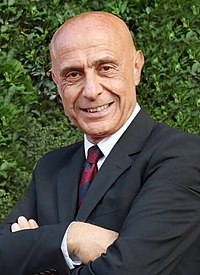President of Adamantina
This article is incomplete because it is pending further input from participants, or it is a work-in-progress by one author. Please comment on this article's talk page to share your input, comments and questions. Note: To contribute to this article, you may need to seek help from the author(s) of this page. |
| President of the Adamantine Republic | |
|---|---|
| Presidente della Repubblica Adamantina | |
| Style | His Excellency (in international relations only) |
| Status | Head of State |
| Appointer | Electoral college |
| Term length | Four years |
| Inaugural holder | TBD |
| Formation | 1808 |
| Salary | $70,000 annually |
The President of Adamantina officially the President of the Adamantine Republic (Italian: Presidente della Repubblica Adamantina), is both head of state and head of government of Adamantina. Under the constitution, the president serves and directs the executive branch as the chief executive of the federal government, and is the commander-in-chief of the Adamantine Armed Forces.
The position of President was first created under the constitution set by the Adamantine Constitution of 1808, which established the United Provinces of Asterias Inferior. The powers of the president were modified by Adamantine Constitution of 1814 after the conclusion of the First Adamantine Civil War and again in 1975 by the current modern constitution. The manner in which the President of Adamantina was elected has also shifted significantly throughout history, from 1808 to 1814 the president was selected by the Senate of Adamantina, one of the main causes of the First Adamantine Civil War. The 1873 constitution created the electoral college, a group of delegates who elected the president. These delegates were from 1873 to 1914 selected by the provincial legislatures. While the electoral college still exists, the delegates are elected through popular vote in each province.
While the power and prestige of the presidency has waned and grown throughout history, the presidency has become increasingly more influential since the 20th century, with the reelection of Antonio Malito in 1976 during the Peony Revolution apart of the wider movement known as the Asterian Spring. The president also plays an important role in federal legislation, domestic and foreign policymaking. It was established as apart of a series of checks and balances, and has historically always wielded the ability to sign or veto federal legislation. From the 1950s until the 2000s, the presidency wielded a great deal of authority within their own political parties, and significantly shaped the policymaking of their respective political organizations.
